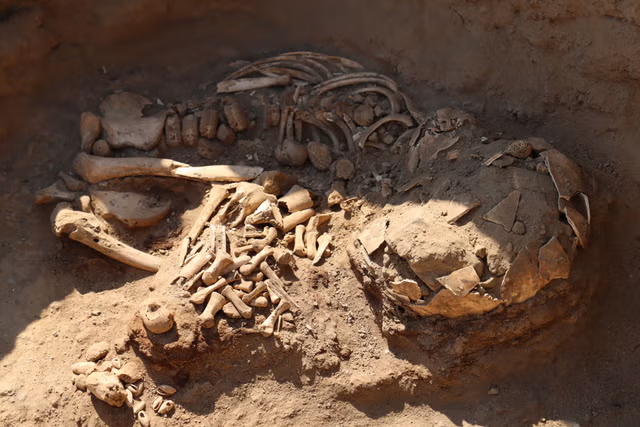Archaeologists have shed light on how prehistoric humans in North America hunted megafauna, such as mammoths.
The research, published in the journal PLOS ONE, proposes that these hunters used razor-sharp stone tools known as Clovis points to kill prey by planting them in the ground and angling them upward to impale charging animals.
Such a method would have been capable of delivering fatal blows to the massive creatures that lived in North America during the Pleistocene epoch, like mammoths, mastodons, saber-toothed cats and bison.
This hypothesis introduces a novel perspective on prehistoric hunting techniques.
Scholars have previously suggested a range of hypotheses for how they were used. These include proposals that hunters fitted Clovis points to sticks to use as spear-like weapons, which were either thrown at prey or thrust into them. Some have suggested the tools were employed to harvest resources from wounded animals.
Clovis points, named after their initial discovery site in Clovis, New Mexico, have long fascinated archaeologists. These meticulously crafted stone tools, known for their sharp edges and distinctive indentations on both sides of their base, were widely used by humans across North America roughly 13,000 years ago. Thousands of them have been recovered to date, with some even found within preserved mammoth skeletons.
For decades, scholars have debated how these points were employed in hunting. But in the latest study, a team led by Scott Byram, a research associate with the University of California, Berkeley's Archaeological Research Facility, challenges these assumptions.
By reviewing historical evidence and conducting experimental tests, the research team suggests that Clovis points were part of a sophisticated hunting system designed to immobilize and fatally wound large animals through a planted spear technique. With this method, the hunters may have braced the butt of their pointed spears against the ground and angled the weapon upward in a way that would impale a charging animal.
In the study, Byram and his team analyzed global historical records of hunting methods involving planted spears and conducted tests to simulate the impact of a charging animal on a stationary spear.
The researchers discovered that once a charging animal's flesh was pierced by the Clovis point, the weapon's design caused it to function similarly to a modern-day hollow-point bullet, causing significant internal damage. This method would have allowed prehistoric hunters to take down enormous animals like mastodons and saber-toothed cats with minimal physical effort.
"The kind of energy that you can generate with the human arm is nothing like the kind of energy generated by a charging animal. It's an order of magnitude different," Jun Sunseri, a co-author of the study and a Berkeley associate professor of anthropology, said in the release.
The research team's findings suggest that early humans did not rely solely on strength to hunt large prey but instead used their ingenuity to create a more efficient and deadly weapon.
"This ancient Native American design was an amazing innovation in hunting strategies," Byram said in a press release. "This distinctive Indigenous technology is providing a window into hunting and survival techniques used for millennia throughout much of the world."
Sunseri emphasized the importance of viewing Clovis points as part of a larger engineered system.
"You have to look beyond the simple artifact," Sunseri said. "One of the things that's key here is that we're looking at this as an engineered system that requires multiple kinds of sub-specialties within our field and other fields."
The study also involved Kent Lightfoot, a Berkeley anthropology professor, who pointed out that the sophistication of Clovis technology demonstrates the ingenuity of early Indigenous people.
"The sophisticated Clovis technology that developed independently in North America is testimony to the ingenuity and skills that early Indigenous people employed in their cohabitation of the ancient landscape with now-extinct megafauna," Lightfoot said.
Looking ahead, the Berkeley team plans to further test their hypothesis by constructing a replica of a mammoth and simulating an attack using Clovis-tipped pikes. This experiment, which will involve a slide or pendulum mimicking the force of a massive, fast-moving animal, aims to provide additional insights into how early humans might have used these tools in real hunting scenarios.
"[The research] puts pike hunting front and center with extinct megafauna," Byram said. "It opens up a whole new way of looking at how people lived among these incredible animals during much of human history."
Do you have a tip on a science story that Newsweek should be covering? Do you have a question about archaeology? Let us know via science@newsweek.com.
Disclaimer: The copyright of this article belongs to the original author. Reposting this article is solely for the purpose of information dissemination and does not constitute any investment advice. If there is any infringement, please contact us immediately. We will make corrections or deletions as necessary. Thank you.



